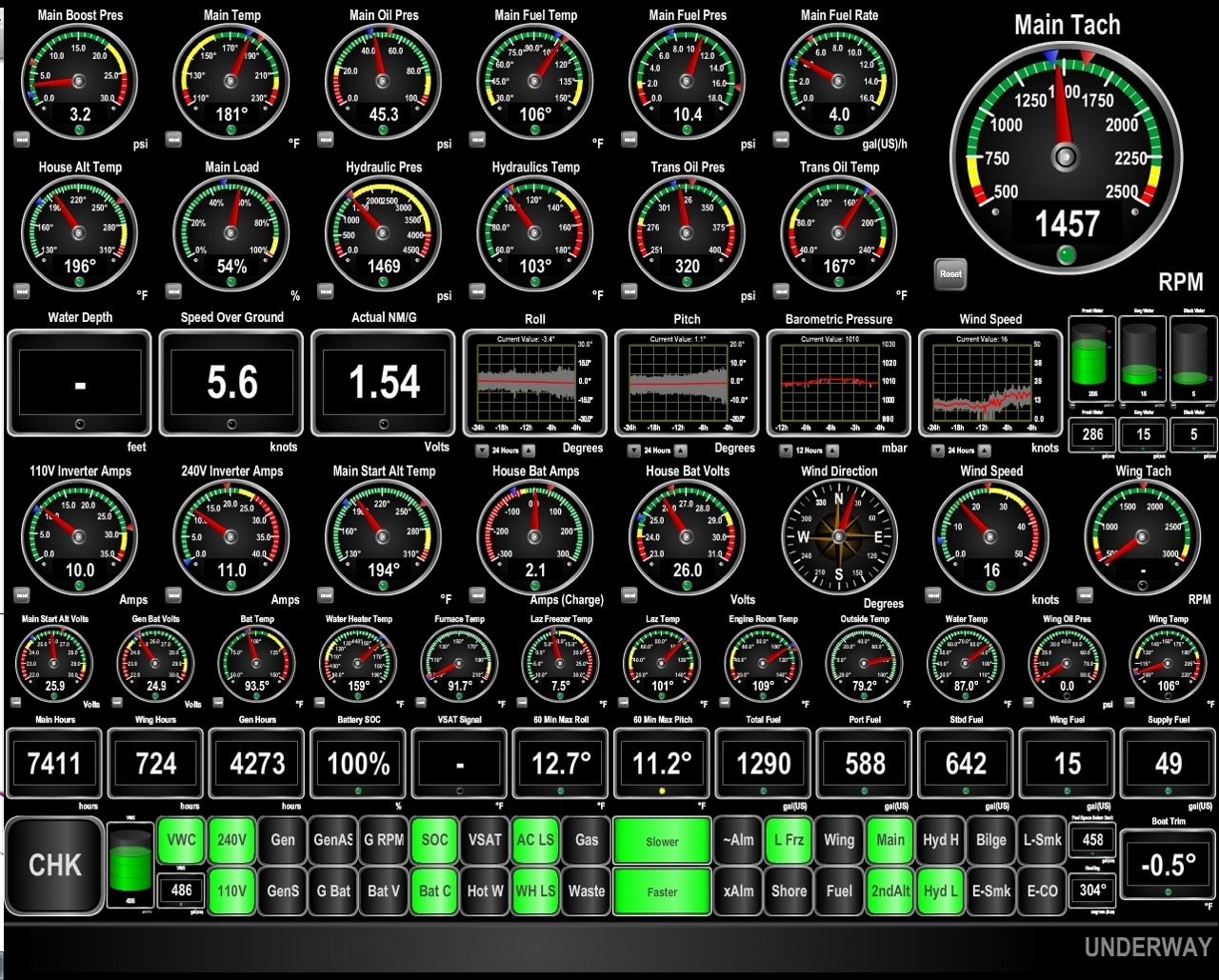While not the greatest expense of running a boat, I watch our fuel closely so here are a few particulars of our trip.
We have four fuel tanks on board. Three tanks are used for storage, and one tank feeds the machinery. There are two 400 gallon storage tanks, one 150 gallon storage tank, and a 150 gallon operating tank.
Fuel use is tracked with a ruler, a chart of burn for RPM, and a flow meter. Every morning I look at the engine hour meter and generator hour meter so I can begin to guess how much fuel to transfer. I also keep a log while the boat is running and make notes on a fairly regular basis of what RPM we are turning and speed.
Now that I know how many hours the engine ran for, I look at my RPM chart for fuel burn and take a guess at consumption.
I don't know the exact generator burn but have been using 1/2 gallon per hour.
Now, with a pretty good idea of how much I'm going to transfer, I go to the ER, and measure the liquid level of the operating tank with a ruler and record in my fuel log. I then decide which tank I'm going to transfer from, move the appropriate valve, zero out my flow meter, transfer "X" amount of gallons to the operating tank, then measure the liquid level again. For my operating tank, a measurement of 26" gives me 90 gallons and that's my benchmark for the tank.
This is a low tech, simple way for me to track fuel and has proven to be very accurate. When transferring from storage tanks to the operating tank, fuel passes through a large Racor filter/separator. From the operating tank to the engine or generator, the fuel goes through another Racor filter/separator before passing through the generator or engine filters. I feel 100% confident of the quality of the fuel.
Over the course of a few months some of my numbers start to get a little jumbled. I might not transfer enough fuel to get exactly to the bench mark, or possibly transfer over the bench mark a bit. Also, my ruler is black on one side to make reading it easier, but you never really get dead nut reading, so there's always a bit of error and guessing. So after few months or so, I'll take some time to total the fuel on the boat. Totaling the fuel on board is done by pumping one tank empty into tank "X", and record the flow meter total, then pump that same amount of fuel form tank "X" back into the just emptied tank. I repeat that for all four tanks to get the exact amount of fuel on board.
Some of the numbers from the Key West Trip are:
359 Miles
174 gallons of fuel
Engine hours 57.7
Generator hours 81.4
Moving average 6.5 kt
Max speed 11.4 kt
Generator fuel used 40.7
Engine fuel used 133.3
Engine fuel efficiency 2.69 NM/Gallon
Boat fuel efficiency ( includes generator) 2.06 NM/Gallon
The boat was mostly ran at 1600 RPM with favoring 1700 quite a bit. I'd prefer to run at 1500, but I was having to maintain speed to get to where we wanted by dark, so I ran a fuzz harder than I'd prefer. I think if I'd stuck with 1500 I could have hit 3 NM/Gallon on engine efficiency.
A@B Marina charged us $132 per night for a five night total of $660. I think our electric bill with A@B was $25.00. We did one pump out at A@B, so with tax and the pump out, our total was about $725.00.
We had enough fuel on board to do this trip, but with my pre-trip guesstimate of burning 200 gallons, we added that amount of fuel prior to leaving Ft. Myers. The fuel cost for this trip @ $2.00 per gallon was about $350.00
I don't pay much attention to food on board as a cost because we have to eat no matter where we are. As all of our other trips, we loaded way more food on board than we needed, and ended up bringing much of it back home.
The trip was ten days, and for whole duration of the trip there were five of us on board. Once in Key West, we had eight on board. We have two heads, two showers, and three sinks. The cabins, all below deck, consists of the master cabin with a walk around queen, and the forward cabin with four permanent bunks. Above, salon table folds down for a blow up queen, we also have a reclining love seat that some of the kids favor to sleep in. The wheel house table can fold down for a blow up full size mattress, but I don't let anyone sleep up there as that's my space. With six kids, we have large family, so we have to make due how we can. Oh yeah, we also have a lap dog that comes with my wife!!
This spring break trip was a big success for us. The reason I have this, among many reasons, is for trips like these as they're affordable, unique, fun, and challenging. This lifestyle defines me on a certain level, and I'm glad the rest of my family enjoys it and embraces it. I missed not having my two college age kids with us as they're up north going to school, but we're planning a summer trip with them to the Dry Tortugas via Key West.
Cheers,
Conall



